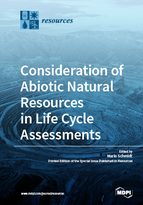Consideration of Abiotic Natural Resources in Life Cycle Assessments
A special issue of Resources (ISSN 2079-9276).
Deadline for manuscript submissions: closed (15 December 2015) | Viewed by 132964
Special Issue Editor
Interests: resource efficiency; resource depletion; life cycle assessment; material flow cost accounting; circular economy
Special Issues, Collections and Topics in MDPI journals
Special Issue Information
Dear Colleagues,
The conservation of natural resources and improvement of resource efficiency have become internationally important goals in the past decade. Industry too is readily taking up the topic of resource efficiency, as there are both environmental and economic reasons in favour of this. For example, many companies would like to know what materials and pre-products are likely to encounter supply shortages in future, or become the subject of public discussion on the grounds of environmental or social impacts.
However, realising this aim in concrete terms is difficult. What resources are in fact involved? Only the “critical raw materials”? What is the significance of resources such as “land” or “water” alongside the abiotic mineral raw materials? What about ecosystem services? What indicators are used to measure the use of resources or resource efficiency? What assumptions are connected with the selection of indicators? For example, are regional shifts or the criticality of the resources taken into account?
One important instrument for analysing product and service systems is the Life Cycle Assessment (LCA) in accordance with ISO 14040 and 14044. It covers all the important energy and material flows occurring during the life cycle of a product. This means that we generally also trace back what raw materials have been used for a product or a service. This is necessary in order to consider all the major environmental pollutions occurring. That is why an LCA is always also an analysis of the use of resources. But how detailed is the examination of the raw materials? Are those raw materials that currently play a major role in resource policy included too, in other words, the “critical metals”? Are there any valid datasets for LCAs on the extraction of unusual raw materials, such as dysprosium, tantalum or indium?
For some time now, discussion has been ongoing in the LCA community about whether the use of resources should also be considered as a separate area of protection, such as is already the case for environmental, health or social safeguard subjects. This is then also linked to the question of what indicators can serve for an aggregation and evaluation of the individual resource consumption rates. Here for example there are sum indicators such as the Total Material Requirement (TMR) or the Direct Material Input (DMI), as well as academically sophisticated approaches, such as exergy, which is automatically connected with resource extraction.
The planned Special Issues of Resources is, therefore, examining the interface between life-cycle-thinking and resource management. We are looking in particular for articles that deal
- explicitly with considering the use of natural resources in specific LCAs,
- with data from mining extraction or recycling of critical raw materials,
- with the selection of suitable indicators to map and aggregate the use of resources, or
- with the formulation of areas of protection for natural raw materials or their embedding in a system of areas of protection.
Further suggestions are welcome.
Prof. Dr. Mario Schmidt
Guest Editor
Manuscript Submission Information
Manuscripts should be submitted online at www.mdpi.com by registering and logging in to this website. Once you are registered, click here to go to the submission form. Manuscripts can be submitted until the deadline. All submissions that pass pre-check are peer-reviewed. Accepted papers will be published continuously in the journal (as soon as accepted) and will be listed together on the special issue website. Research articles, review articles as well as short communications are invited. For planned papers, a title and short abstract (about 100 words) can be sent to the Editorial Office for announcement on this website.
Submitted manuscripts should not have been published previously, nor be under consideration for publication elsewhere (except conference proceedings papers). All manuscripts are thoroughly refereed through a single-blind peer-review process. A guide for authors and other relevant information for submission of manuscripts is available on the Instructions for Authors page. Resources is an international peer-reviewed open access monthly journal published by MDPI.
Please visit the Instructions for Authors page before submitting a manuscript. The Article Processing Charge (APC) for publication in this open access journal is 1600 CHF (Swiss Francs). Submitted papers should be well formatted and use good English. Authors may use MDPI's English editing service prior to publication or during author revisions.
Keywords
- Life Cycle Assessment
- abiotic natural resources
- resource scarcity
- mining
- critical raw materials
- safeguard subjects
- dissipation of resources
- recycling innovation






